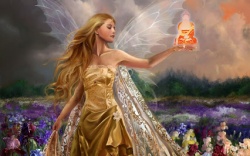Simile and Parable
"Simile and Parable" chapter
譬喩品 (Jpn Hiyu-hon )
The third chapter of the Lotus Sutra. It begins with Shariputra expressing his joy at having understood Shakyamuni's teaching of "the true aspect of all phenomena" in the previous chapter, "Expedient Means," and stating the following realization: "Today at last I understand that truly I am the Buddha's son, born from the Buddha's mouth, born through conversion to the Law, gaining my share of the Buddha's Law!" Shakyamuni then prophesies that, in the far distant future, Shariputra will become a Buddha named Flower Glow.
This prophecy is significant because Shariputra represents the people of the two vehicles (voice-hearers and cause-awakened ones), who in the provisional Mahayana teachings are barred from ever attaining Buddhahood. In predicting that Shariputra will attain Buddhahood, Shakyamuni substantiates the message in the "Expedient Means" chapter that all people can become Buddhas.
Up until this point in the sutra, only Shariputra has grasped what Shakyamuni Buddha is expounding. So that others might understand, the Buddha relates the following parable of the three carts and the burning house: There is a very rich man who has many children. One day a fire suddenly breaks out in his spacious but decaying house, and his children, totally absorbed in playing games, do not know that the house is in flames and ignore his cries of warning. He therefore resorts to an expedient means to induce them to come out of the burning house. He shouts to them that outside he has three kinds of carts they have long wanted, pulled respectively by a goat, a deer, and an ox. Immediately the children race one another out of the door. Having coaxed them to safety in this way, the rich man gives each of his children a cart, not of the three kinds he had promised, but a much finer carriage adorned with numerous jewels and drawn by a white ox.
In this parable, the father represents the Buddha, his children represent the people, and the burning house represents this world, which is filled with suffering; the three kinds of carts originally promised represent the three vehicles, or the provisional teachings, and the great white ox carriage symbolizes the supreme vehicle of Buddhahood, i.e., the Lotus Sutra. The parable is employed to illustrate that the three vehicles of voice-hearers, cause-awakened ones, and bodhisattvas are simply means to lead people to the one Buddha vehicle. The latter part of this chapter emphasizes the importance of faith, pointing out that even Shariputra, known as foremost in wisdom, could "gain entrance through faith alone" and not through his own wisdom or understanding. The "Simile and Parable" chapter also describes the terrible consequences of slandering the Lotus Sutra and its practitioners.
